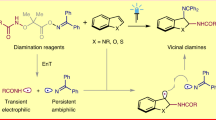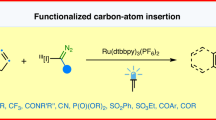Abstract
Carbon has the unique ability to bind four atoms and form stable tetravalent structures that are prevalent in nature. The lack of one or two valences leads to a set of species—carbocations, carbanions, radicals and carbenes—that is fundamental to our understanding of chemical reactivity1. In contrast, the carbyne—a monovalent carbon with three non-bonded electrons—is a relatively unexplored reactive intermediate2,3,4,5,6; the design of reactions involving a carbyne is limited by challenges associated with controlling its extreme reactivity and the lack of efficient sources7,8,9. Given the innate ability of carbynes to form three new covalent bonds sequentially, we anticipated that a catalytic method of generating carbynes or related stabilized species would allow what we term an ‘assembly point’ disconnection approach for the construction of chiral centres. Here we describe a catalytic strategy that generates diazomethyl radicals as direct equivalents of carbyne species using visible-light photoredox catalysis. The ability of these carbyne equivalents to induce site-selective carbon–hydrogen bond cleavage in aromatic rings enables a useful diazomethylation reaction, which underpins sequencing control for the late-stage assembly-point functionalization of medically relevant agents. Our strategy provides an efficient route to libraries of potentially bioactive molecules through the installation of tailored chiral centres at carbon–hydrogen bonds, while complementing current translational late-stage functionalization processes10. Furthermore, we exploit the dual radical and carbene character of the generated carbyne equivalent in the direct transformation of abundant chemical feedstocks into valuable chiral molecules.
This is a preview of subscription content, access via your institution
Access options
Access Nature and 54 other Nature Portfolio journals
Get Nature+, our best-value online-access subscription
$29.99 / 30 days
cancel any time
Subscribe to this journal
Receive 51 print issues and online access
$199.00 per year
only $3.90 per issue
Buy this article
- Purchase on Springer Link
- Instant access to full article PDF
Prices may be subject to local taxes which are calculated during checkout





Similar content being viewed by others
References
Trost, B. M. & Fleming, I. Comprehensive Organic Synthesis (Pergamon, 1991)
Thap, D. M., Gunning, H. E. & Strausz, O. P. Formation and reactions of monovalent carbon intermediates. I. Photolysis of diethyl mercuribisdiazoacetate. J. Am. Chem. Soc. 89, 6785–6787 (1967)
Strausz, O. P., Thap, D. M. & Font, J. Formation and reactions of monovalent carbon intermediates. II. Further studies on the decomposition of diethyl mercurybisdiazoacetate. J. Am. Chem. Soc. 90, 1930–1931 (1968)
Strausz, O. P. et al. Formation and reactions of monovalent carbon intermediates. III. Reaction of carbethoxymethyne with olefins. J. Am. Chem. Soc. 96, 5723–5732 (1974)
Patrick, T. B. & Kovitch, G. H. Photolysis of diethyl mercurybisdiazoacetate and ethyl diazoacetate in chloroalkanes. J. Org. Chem. 40, 1527–1528 (1975)
Patrick, T. B. & Wu, T.-T. Photodecomposition of diethyl mercurybis(diazoacetate) in several heterocyclic systems. J. Org. Chem. 43, 1506–1509 (1978)
Fürstner, A. Alkyne metathesis on the rise. Angew. Chem. Int. Ed. 52, 2794–2819 (2013)
Bino, A., Ardon, M. & Shirman, E. Formation of a carbon-carbon triple bond by coupling reactions in aqueous solution. Science 308, 234–235 (2005)
Bogoslavsky, B. et al. Do carbyne radicals really exist in aqueous solution? Angew. Chem. Int. Ed. 51, 90–94 (2012)
Cernak, T., Dykstra, K. D., Tyagarajan, S., Vachal, P. & Krska, S. W. The medicinal chemist’s toolbox for late stage functionalization of drug-like molecules. Chem. Soc. Rev. 45, 546–576 (2016)
Swings, P. & Rosenfeld, L. Considerations regarding interstellar molecules. Astrophys. J. 86, 483–486 (1937)
Rydbeck, O. E. H., Ellder, J. & Irvine, W. M. Radio detection of interstellar CH. Nature 246, 466–468 (1973)
Morris, P. W. et al. Herschel/HIFI spectral mapping of C+, CH+, and CH in Orion BN/KL: the prevailing role of ultraviolet irradiation in CH+ formation. Astrophys. J. 829, 15–46 (2016)
Landau, E. Building Blocks of Life’s Building Blocks Come From Starlight. https://www.jpl.nasa.gov/news/news.php?feature=6645 (JPL, 2016)
Ford, A. et al. Modern organic synthesis with α-diazocarbonyl compounds. Chem. Rev. 115, 9981–10080 (2015)
Nicewicz, D. A. & MacMillan, D. W. C. Merging photoredox catalysis with organocatalysis: the direct asymmetric alkylation of aldehydes. Science 322, 77–80 (2008)
Prier, C. K., Rankic, D. A. & MacMillan, D. W. C. Visible light photoredox catalysis with transition metal complexes: applications in organic synthesis. Chem. Rev. 113, 5322–5363 (2013)
Yoshimura, A. & Zhdankin, V. V. Advances in synthetic applications of hypervalent iodine compounds. Chem. Rev. 116, 3328–3435 (2016)
Wang, L. & Liu, J. Synthetic applications of hypervalent iodine(III) reagents enabled by visible light photoredox catalysis. Eur. J. Org. Chem. 2016, 1813–1824 (2016)
Weiss, R., Seubert, J. & Hampel, F. α-Aryliodonio diazo compounds: SN reactions at the α-C atom as a novel reaction type for diazo compounds. Angew. Chem. Int. Ed. Engl. 33, 1952–1953 (1994)
Schnaars, C., Hennum, M. & Bonge-Hansen, T. Nucleophilic halogenations of diazo compounds, a complementary principle for the synthesis of halodiazo compounds: experimental and theoretical Studies. J. Org. Chem. 78, 7488–7497 (2013)
Boursalian, G. B., Ham, W. S., Mazzotti, A. R. & Ritter, T. Charge-transfer-directed radical substitution enables para-selective C–H functionalization. Nat. Chem. 8, 810–815 (2016)
Ye, F. et al. Palladium-catalyzed C-H functionalization of acyldiazomethane and tandem cross-coupling reactions. J. Am. Chem. Soc. 137, 4435–4444 (2015)
Fu, L., Mighion, J. D., Voight, E. A. & Davies, H. M. L. Synthesis of 2,2,2,-trichloroethyl aryl- and vinyldiazoacetates by palladium-catalyzed cross-coupling. Chem. Eur. J. 23, 3272–3275 (2017)
Lovering, F., Bikker, J. & Humblet, C. Escape from flatland: increasing saturation as an approach to improving clinical success. J. Med. Chem. 52, 6752–6756 (2009)
Schönherr, H. & Cernak, T. Profound methyl effects in drug discovery and a call for new C-H methylation reactions. Angew. Chem. Int. Ed. 52, 12256–12267 (2013)
Le, C., Liang, Y., Evans, R. W., Li, X. & Macmillan, D. W. C. Selective sp3 C–H alkylation via polarity-match-based cross-coupling. Nature 547, 79–83 (2017)
Caballero, A. et al. Silver-catalyzed C−C bond formation between methane and ethyldiazoacetate in supercritical CO2 . Science 332, 835–838 (2011)
Panish, R., Selvaraj, R. & Fox, J. M. Rh(II)-catalyzed reactions of diazoesters with organozinc reagents. Org. Lett. 17, 3978–3981 (2015)
Qin, T. et al. A general alkyl-alkyl cross-coupling enabled by redox-active esters and alkylzinc reagents. Science 352, 801–805 (2016)
Zhu, Z., Bally, T., Stracener, L. & McMahon, R. J. Reversible interconversion between singlet and triplet 2-naphthyl(carbomethoxy)carbene. J. Am. Chem. Soc. 121, 2863–2874 (1999)
Acknowledgements
This work was funded by the ICIQ Foundation, the CERCA Programme (Generalitat de Catalunya), MINECO (CTQ2016-75311-P, AEI/FEDER-EU; Severo Ochoa Excellence Accreditation 2014–2018, SEV-2013-0319), the CELLEX Foundation through the CELLEX-ICIQ high-throughput experimentation platform. We thank the European Union for a Marie Curie-COFUND post-doctoral fellowship (to Z.W.) and the CELLEX Foundation for pre-doctoral (to A.G.H.) and post-doctoral fellowships (to A.M.d.H.). We thank the ICIQ Research Support Area, and F. Bravo for LC/MS instrumentation. M.G.S. is a Junior Group Leader of the ICIQ Starting Career Programme 2014−2019.
Author information
Authors and Affiliations
Contributions
M.G.S. conceived the idea of developing new hypervalent iodine reagents for the generation of carbynes. Z.W., A.G.H. and A.M.d.H. performed the experiments. M.G.S. wrote the manuscript. All authors contributed to the analysis and interpretation of the data and commented on the final draft of the manuscript.
Corresponding author
Ethics declarations
Competing interests
M.G.S. and Z.W. have filed a provisional patent application (number EP17382063) through the Fundació Institut Català D’Investigació Química (ICIQ) that is based on the results presented here.
Additional information
Reviewer Information Nature thanks I. Larrosa and the other anonymous reviewer(s) for their contribution to the peer review of this work.
Publisher's note: Springer Nature remains neutral with regard to jurisdictional claims in published maps and institutional affiliations.
Supplementary information
Supplementary Information
This file contains Supplementary Text and Data – see contents page for details. (PDF 8488 kb)
Rights and permissions
About this article
Cite this article
Wang, Z., Herraiz, A., del Hoyo, A. et al. Generating carbyne equivalents with photoredox catalysis. Nature 554, 86–91 (2018). https://doi.org/10.1038/nature25185
Received:
Accepted:
Published:
Issue Date:
DOI: https://doi.org/10.1038/nature25185
This article is cited by
-
Ring expansion of indene by photoredox-enabled functionalized carbon-atom insertion
Nature Catalysis (2024)
-
Drug design via single-carbon atom insertion
Nature Catalysis (2024)
-
Synthesis and reactivity of copper carbyne anion complexes
Nature Synthesis (2023)
-
An isolable germylyne radical with a one-coordinate germanium atom
Nature Chemistry (2023)
-
Carbyne anions get to work
Nature Synthesis (2023)
Comments
By submitting a comment you agree to abide by our Terms and Community Guidelines. If you find something abusive or that does not comply with our terms or guidelines please flag it as inappropriate.



